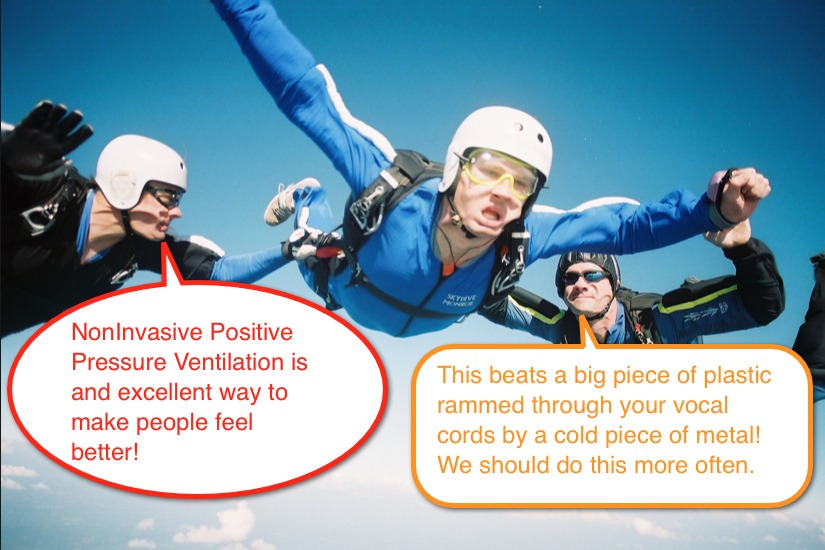Noninvasive Ventilation
The decision to intubate a patient is, unquestionably, one of the most significant (and at times intimidating) decisions that we make. In preparation and consideration for all of the potential complications and outcomes of the intubation, it is common to use the analogy of going skydiving: You wouldn’t go skydiving without a backup parachute. Personally, I like skydiving (went for my Bachelor party many moons ago) and I think that we should use skydiving to remind us that NONINVASIVE VENTILATION is a great plan to help us avoid needing to jump out of the plane in the first place.
Noninvasive Ventilation
- Comes in two primary forms
- Positive Pressure (generally what we use – BiPAP, CPAP, High Flow Nasal Cannula)
- Negative Pressure
- Hasn’t been around that long …
- First use was in adults in the 1980’s
- In the 1990’s, High Flow Nasal Cannula systems began to be used in the NICU
- While popular, there is not a lot of “rigorous” literature
- Outcome measures vary between studies
- The specific systems used and the type of noninvasive ventilation vary
- Most studies are single-center studies
- Difficult to have a Control Group
- Most literature is of Case Series / Retrospective Reviews
- One Randomized Control Trial (Yanez 2008)
- 50 patients randomized to conventional therapy or conventional PLUS BiPAP.
- The noninvasive ventilation group had significantly less intubations compared to conventional group (28% vs 60%).
- The two groups were not identical (the BiPAP group had initial lower oxygen requirements).
Common Themes of Research of Noninvasive Ventilation in Pediatrics
- Noninvasive ventilation (CPAP, BiPAP, and High Flow NC) is a well tolerated.
- Patients who respond to noninvasive ventilation typically show improvements within the first 1-2 hours!
- Use of noninvasive ventilation is associated with lower rates of intubation (which is the idea!)
Predictors of Noninvasive Ventilation Failure
- Multiorgan dysfunction
- Worsening respiratory acidosis (pH less than 7.25 after 1-2 hrs of noninvasive ventilation)
- Underlying diagnosis of sepsis, immunosuppresion, or oncologic disease process
- Higher oxygen requirement prior to initiation of therapy
- Inability to reduce the FiO2 in the presence of a high mean airway pressure
Noninvasive Ventilation as Part of the Kitchen Sink
As we mentioned last week, and in other Morsels, I like to throw the entire Kitchen Sink at patients who are presenting with severe asthma. I think many of us would place noninvasive ventilation within that collection of tools.
- Ok, so the literature supporting it is not robust. I don’t know if it ever will be; however, what is the harm?
- Similar to Magnesium for severe asthma, the risk : benefit ratio is definitely in favor of the noninvasive ventilation.
- Consider it early on!
- We see that the kids who have progressed further down the slope of respiratory failure are less likely to benefit
- Watch them closely and reassess often.
- If there is going to be an improvement, it will be evident within that first 1-2 hours.
- If you haven’t made any improvements by then, it is time to consider moving onward.
- Be leery of Sepsis (or the medically complicated)
- Those with pure respiratory issues appear to do better with noninvasive ventilation.
Take a look at the Marohn article from 2013… it is a good review!
Yanez LJ, Yunge M, Emilfork M, et al. A prospective, randomized, controlled trial of noninvasive ventilation in pediatric acute respiratory failure. Pediatr Crit Care Med. 2008; 9: 484-489. Marohn K, Panisello JM. Noninvasive ventilation in pediatric intensive care. Curr Opin Pediatr. 20013; 25: 290-296.



[…] Noninvasive Ventilation Avoid Oxygen Desats […]